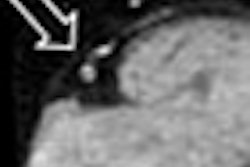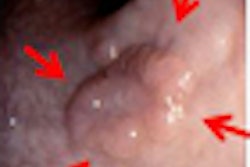The use of prospective gating in CT angiography (CTA) scans can dramatically reduce theoretical cancer risks associated with the heart exams -- by as much as 87% over retrospective gating -- according to a new study published online in the British Journal of Radiology.
Prospective electrocardiogram (ECG) gating in coronary CTA activates the scanner's x-ray tube only during a narrow acquisition window during the cardiac cycle. The technique has been shown to reduce radiation dose by as much as 60% to 90% compared to retrospective ECG gating, which scans during the entire cardiac cycle. Images of the coronary arteries are of equivalent quality with both techniques, although prospectively acquired data cannot be used for functional CT studies of the heart, needed in some patients to assess the impact of a stenosis on cardiac function.
In their study, Dr. Pek-Lan Khong and colleagues from the University of Hong Kong, Queen Mary Hospital in Hong Kong, and GE Healthcare of Chalfont St. Giles, U.K., aimed to estimate both radiation dose and cancer risks to adults associated with both retrospectively and prospectively gated coronary CTA techniques (Br J Radiol online, February 2010, Vol. 83, pp. 152-158).
They relied on ImPACT (Imaging Performance Assessment of CT Scanners) spreadsheets to simulate patient doses using both acquisition techniques. For retrospectively gated coronary CTA using pitches of 0.20, 0.22, and 0.24, the effective doses in men were 27.7, 23.6, and 20.7 mSv respectively. For women the corresponding doses were 23.6, 20.0, and 18.8 mSv, respectively.
In comparison, the dose for prospective ECG-gated CTA was 3.7 mSv for both men and women.
The researchers then developed a table of lifetime attributable risks (LAR) of cancer incidence that was used to estimate cancer risk for a hypothetical 50-year-old patient in the U.S., U.K., and Hong Kong. The estimates showed drastic reductions in theoretical cancer risk with the use of prospective ECG gating.
Lifetime attributable cancer risk, retrospective versus prospective ECG gating
|
"Our study shows that prospectively ECG-gated CTA reduces radiation dose and cancer risks by up to 87% compared with retrospectively ECG-gated CTA," Khong and colleagues concluded.
By Eric Barnes
AuntMinnie.com staff writer
February 9, 2010
Related Reading
NIH tells scanner suppliers to include radiation monitoring, February 1, 2010
Software offers alerts for patients with past CT scans, January 28, 2010
Studies spotlight high CT radiation dose, increased cancer risk, December 14, 2009
Australian software automates data mining of CR dose, September 9, 2009
NEJM study: Imaging procedures, radiation growing, August 26, 2009
Copyright © 2010 AuntMinnie.com



















